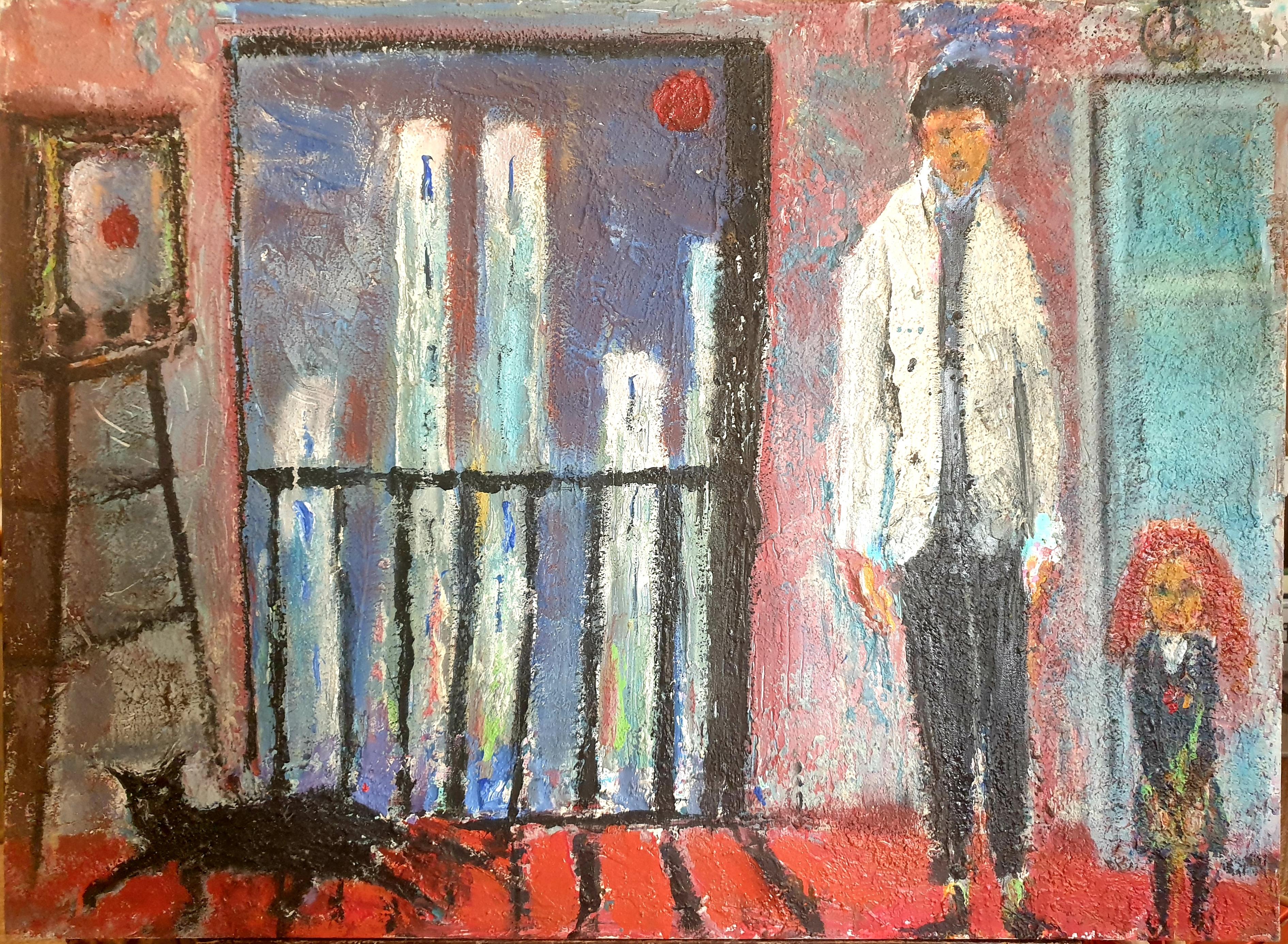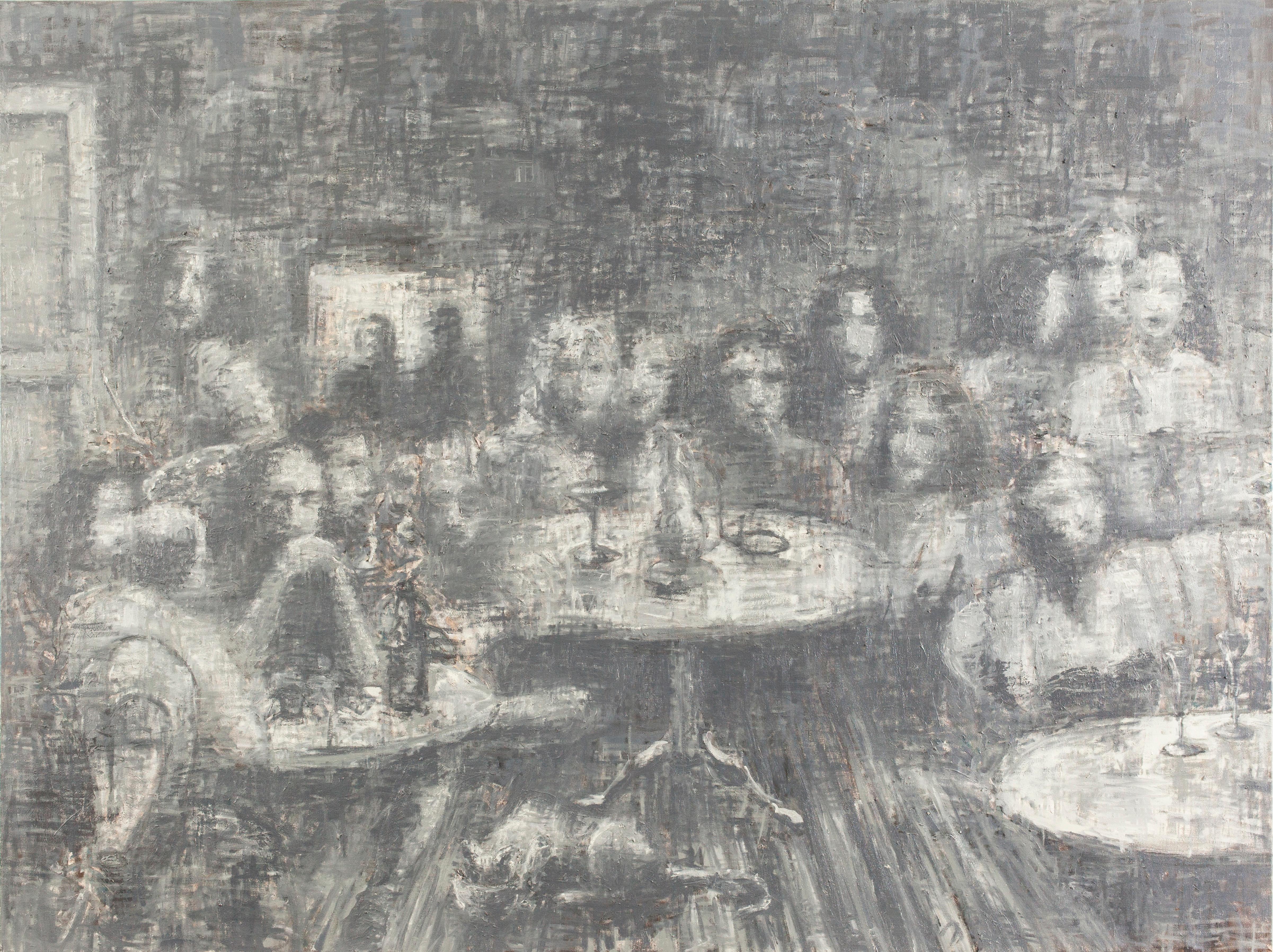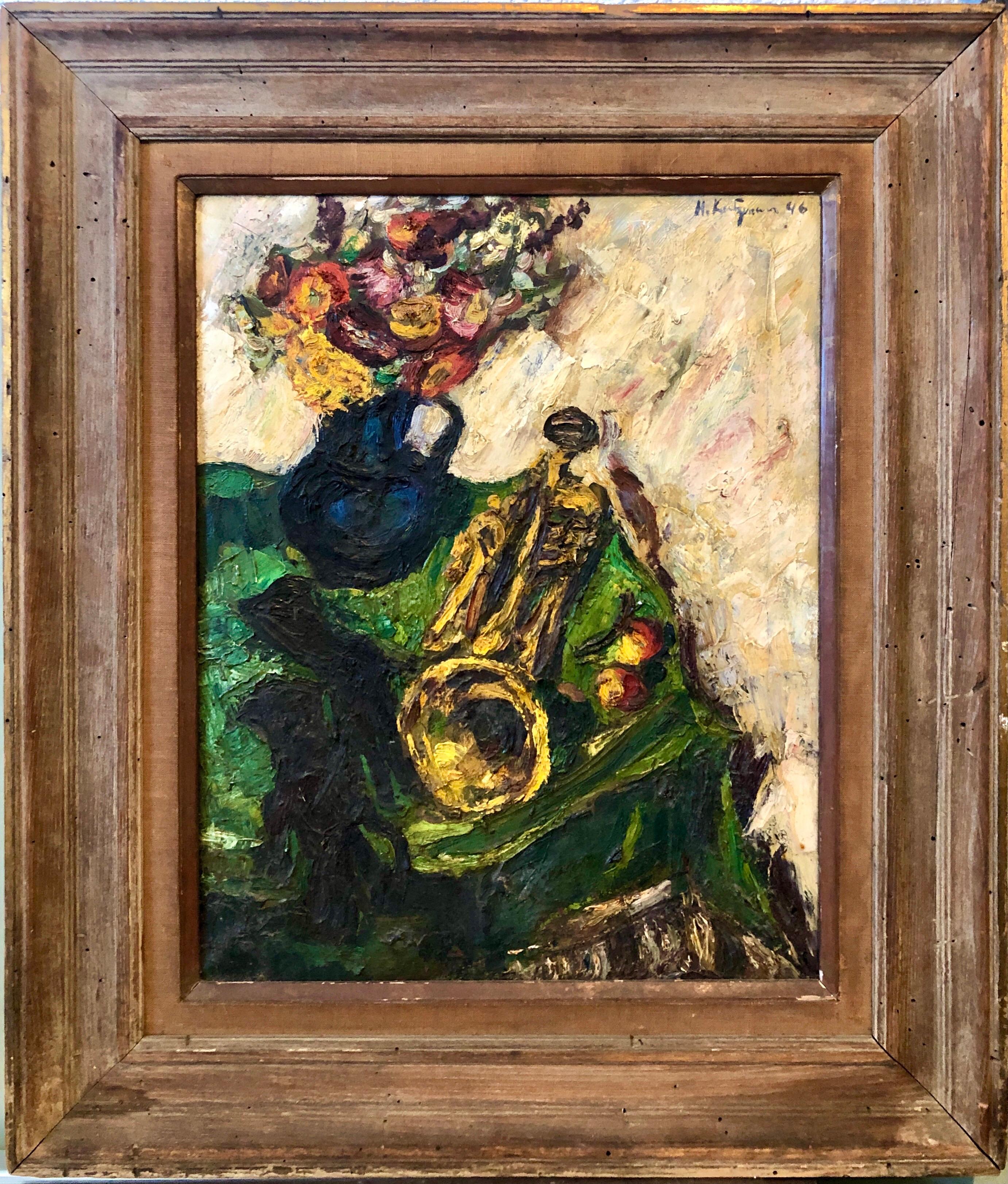Michael Baxte"Interior Scene with Figure" Expressionistic Style Oil Painting on Masonite1969
1969
About the Item
- Creator:Michael Baxte (1890 - 1972, Russian)
- Creation Year:1969
- Dimensions:Height: 21.75 in (55.25 cm)Width: 18 in (45.72 cm)Depth: 0.25 in (6.35 mm)
- Medium:
- Movement & Style:
- Period:
- Condition:This piece is in excellent condition besides some wear on outer edge of the board from age.
- Gallery Location:New York, NY
- Reference Number:
Michael Baxte
Michael Baxte was an American painter. His work was part of the painting event in the art competition at the 1936 Summer Olympics. During the 1930s Baxte and his wife, Violet, lived in France and spent most of their time in Paris, where Baxte became part of the School of Paris and exhibited his artwork in government-sponsored exhibitions, including the Salon d'Automne, helping as well to organize an exhibition of American painters. When World War II began, and Paris became unsafe, Baxte and his wife relocated to Mexico, where they continued to live and work. Baxte died in 1972 in Mexico.
- ShippingRetrieving quote...Ships From: New York, NY
- Return PolicyA return for this item may be initiated within 7 days of delivery.
- "Laying Figure Reading" Post-Impressionist Colorful Oil Painting on Panel FramedBy Jacques ZuckerLocated in New York, NYThis painting depicts a whimsical scene of a figure reclining and reading. The figure is done in a quick way, where the scene almost is abstracted. The bright colors and quick brush ...Category
20th Century Post-Impressionist Figurative Paintings
MaterialsOil, Panel
- "Young Boy with Toy Airplane" Post-Impressionist French Oil Painting on CanvasBy Jacques ZuckerLocated in New York, NYThis painting depicts a whimsical portrait of a young boy with light brown hair against a viridian green background. The piece is done in a highly impressionistic manner and is a won...Category
20th Century Post-Impressionist Figurative Paintings
MaterialsOil, Wood Panel, Canvas
- "Sunday at the Chateau de Chambord" Impressionist Interior Scene with PianoBy Cindy ShaoulLocated in New York, NYA charming depiction of an interior scene with piano. A cozy impressionistic scene with warmth and feeling. Whimsical details through out and beautiful brushwork. This piece captures...Category
2010s Contemporary Interior Paintings
MaterialsCanvas, Oil
- Mother and ChildBy Paul Alexandre Alfred LeroyLocated in New York, NYA wonderful depiction of mother and child displayed in a gold round ornate frame with intricate details.Category
Late 19th Century Realist Figurative Paintings
MaterialsOil, Canvas
- "Interior Scene with Figure and Mantel" Post-Impressionism Oil Painting on PanelBy Jacques ZuckerLocated in New York, NYA cozy little jewel, we are charmed by the rich choice of color and intimate details throughout this miniature work. This painting depicts a woman in her bedroom near the Mantel with...Category
20th Century Post-Impressionist Interior Paintings
MaterialsPanel, Oil
- "Laundry" Post-Impressionism French Oil Painting Interior Scene Figure on BoardBy Jacques ZuckerLocated in New York, NYThis painting depicts a whimsical portrait of a young lady washing her laundry in front of a house. This piece was most likely executed in the 1930's, as the colors are darker than Z...Category
1960s Post-Impressionist Figurative Paintings
MaterialsOil, Board
- Large Expressionist Oil on Canvas, Apartment Interior and Cityscape.By Ernst Ludwig KirchnerLocated in Cotignac, FRA mid century Expressionist oil on canvas of a man, child and cat in an interior with a cityscape beyond. The work is not signed but there are various notations to the top rear stret...Category
Mid-20th Century Expressionist Figurative Paintings
MaterialsOil, Canvas
- Beyond the LimitsLocated in Ibadan, OyoBeyond the Limits is a work that explains what youth in a developing country goes through. Most youth who have to experience the squalor of a developing economy are characterized by wholesale dejection and despair with many of them resorting to drug use and various crimes that jeopardized their lives. Many cannot see a future beyond their present abode. Artist Busari Adewale...Category
21st Century and Contemporary Expressionist Figurative Paintings
MaterialsOil, Acrylic, Canvas
- Paul Manes - Palaz of the Hoon, Painting 2008By Paul ManesLocated in Greenwich, CTPaul Manes was born May 4, 1948, in Austin, Texas. He began his professional career in New York City in the early 1980s. His art has been widely exhibited in America and Europe and h...Category
Early 2000s Expressionist Figurative Paintings
MaterialsCanvas, Paint, Oil
- 1950's Expressionist Interior Oil Painting Still Life with Flowers and TrumpetBy Herbert KatzmanLocated in Surfside, FLHerbert Katzman 1923-2004 (American artist active in New york, Illinois and Italy) Oil Painting Dated 1946. Signed. Dimensions; Sight-16" x 20", Frame-23.5" x 27". Provenance: this bears an old stamp verso from Christie's auction house. Herbert Katzman was born in Chicago on Jan. 8, 1923, His father believing that discipline was a good teacher, sent Herbert and Bob to St. John's military academy for their elementary education but it wasn't long before Herbert found his way to the Art Institute of Chicago where he wanted to study sculpting. His Father vehemently objected and refused to finance his studies, but that wasn't enough to discourage the young artist. He put himself through school working as a student janitor and a few other odd jobs. At 17 he entered the Advanced School of the Art Institute, his interest having turned to painting. His study there was briefly interrupted by a short stint in the navy (1942-44). After receiving a medical discharge, he returned to Chicago to work with Boris Anisfeld, who introduced him to German and French Expressionism...Category
Mid-20th Century Expressionist Figurative Paintings
MaterialsOil, Canvas
- Polish French Jewish Artist Oil Painting Girl with Doll, School of Paris JudaicaBy Walter SpitzerLocated in Surfside, FLFramed 27 X 24 inches Sight 18 X 15 inches Walter Spitzer (Polish/French, 1927 - ) born in Cieszyn, Poland. A Polish Jewish Holocaust survivor, he made his first drawings in a concentration camp. Walter Spitzer has lived and worked since WWII in France, where he studied at the École des Beaux Arts in Paris. Walter Spitzer has achieved great renown as a painter and printmaker. Whether in his paintings of Biblical subjects or in lithographs of Shtetl scenes, His humanity was inspired by the writings of Sartre, Montherlant and Kazantzakis, Walter Spitzer is occupied with two great, interlinked themes: man’s inhumanity to man, and the humanity of man. He will surely be recognized in the future as one of the great witnesses to the twentieth-century experience. Walter Spitzer was born in Chieszyn, Poland, the son of a Jewish liqueur producer, and attended the German school there. He began to draw and paint at an early age. In 1939 the Spitzer family was forcibly removed by the Germans to the town of Strzemieszyce, which was turned into a ghetto in 1942. When the ghetto was liquidated in June 1943 Spitzer’s mother was shot, and the sixteen-year-old Walter was deported to Blechhammer, a subcamp of Auschwitz. There he painted portraits of Wehrmacht soldiers and fellow inmates in exchange for food. He was one of the few to survive the evacuation march from Auschwitz to Buchenwald, where to begin with, in late February 1945, he was held in the Little Camp. To enable him to make drawings documenting life in the camp, the Communists organized his transfer to the main camp. While on a death march in early April he made his escape in the vicinity of Jena and was soon in the hands of the Americans. Spitzer served as an interpreter with an American army unit, and at the same time executed numerous drawings depicting the world of the camps. In June 1945 the Americans took him to Paris, where – following the advice of his father, who had died in 1940 – he began to study art at the École des Beaux-Arts in Par the following year. After completing his training as an artist he produced paintings expressing a critical view of the society of his day. In 1955, in commemoration of the camps and the death marches, he executed a cycle of nine etchings in an edition of thirty, which he gave to various museums in Israel and in France. In the 1960s he established himself as an illustrator of exclusive editions of works by such authors as André Malraux, Jean-Paul Sartre, Joseph Kessel and Nikos Kazantzakis. The Six-Day War prompted him to begin painting subjects from Jewish and Biblical history; At age 19, he was asked to make the scenery for the Edouard VII Theater in Paris, which was showing The Dibbuk of Ansky. In 1947 the same theater asked him to make the scenery for the Hill of Life ( Max Zveig). Spitzer has been a member of the Salon d'Automne since 1952. He was the last remaining survivor of the Montparnasse Ecole de Paris. A group of Jewish expats that included Issachar Ber Ryback, Abel Pann, Abraham Mintchine, Isaac Antcher, Alexandre Altmann, Henri Epstein, Mane Katz, Marcel Janco, Gregoire Michonze...Category
1960s Expressionist Figurative Paintings
MaterialsCanvas, Oil
- Large French Expressionist Oil Painting, Girl, Poupèe, the Doll, Ecole de ParisLocated in Surfside, FLSigned on recto and signed verso, titled, and inscribed Montmartre by the artist. This is a large colorful expressionist painting of a girl doll with long blonde or ginger redhead pigtails. It is titled Poupee 1925 and depicts an Art Deco era flapper girl in a beret. Roger Crusat (French Expressionist artist, poet and lithographer) is known for ballet troupe set design and theatre backdrop painting and architectural motifs. Roger Crusat was born in 1917 in Roussillon, Provence, France. Crusat's early works depict the colorful countryside of Provence in the South of France, As a young man Crusat performed many jobs in the troupe, designing costumes, and even dancing. But, most important, he painted the scenery for the troupe's performances. It was while working in this capacity that he learned the essentials of scenery painting that remain evident in his mature work. Crusat was a student of Andre Fons-Godail at Beaux-Arts in Perpignan when he was called to serve in World War II. After being wounded in 1940, he returned to study under Rene Jaudon at Beaux-Arts in Paris. Crusat was known by his contemporaries as "the Catalan painter of Montmartre" where he lived with his wife until his death in 1994. Cracked and peeling walls framed by rusting water pipes are a common sight in Montmartre. What others considered unnecessary, Crusat included. Water pipes were his cherished motif. Supposed by some to be a symbol of decay and monotony, Crusat's Impressionist water pipes like arteries in the body, convey life. Crusat won the prestigious Prix Populiste for his "Descente d'Eau" (Water Pipes) in 1956. Crusat's mature work retains the essentials of good scenery painting. Intricate detail will not be found, but broad, solid abstract shapes abound. His subtle colors, dense in texture, are meant to compliment his subjects, not distract from them. The critics considered him a lyric expressionist and a "painter of Man" in his portrayal of the anguish of daily life and the regrets of the past. Crusat exhibited at many of the same Salons as the post-impressionists and expressionists. Salon des Independants was co-founded by Georges Seurat. Degas had only one exhibition during his lifetime, and it was at the Galerie Durand Ruel in Paris. Gauguin had also exhibited his Tahitian paintings. Crusat's works were exhibited there in 1955. SELECT AWARDS 1954 Le Prix de la Jeune Peintre 1955 Prix des Amateurs d'Art & des Collectionneurs, Galerie Gazette des Beaux Arts, 140 rue Faubourg St. Honore, Paris Les Jardins des Abbesses purchased by the Republic of France, Prix de la Ville de Marseilles, Prix Othon Friesz 1956 Prix Populiste, Prix de Amedeo Modigliani 1957 Grand Prix International de Vichy, Prix de la Fondation Greenshields 1959 IVeme Grand Prix de Peinture du Festival de Vichy 1967 Le Prix des Amis de Brantôme, Perigord, France 1970 Prix de la Critique Academy de Vernet a Vichy,"La Nuit, Premiere Etude" Roger Crusat, Half-closed shutters , poems enriched with four original lithographs (175 numbered copies) drawn on Henri Deprest's presses on February 13, 1975 , Éditions Matignon 34, 1975. Personal exhibitions Durand-Ruel Gallery, Paris, 1955 [ 1 ] . Galerie Rivière, Paris, november 1958 [ 4 ] . Le Roux and Mathias, auctioneers in Paris, Sale of the Roger Crusat workshop , Hôtel Drouot , Paris, Thursday October 27, 1994 [ 5 ] . Jack's American Bistro, Glens Falls , September- october 2004 [ 6 ] . Collective exhibitions Galerie Roger, Lyon , October 1946 [ 7 ] . Salon des Indépendants , Paris, from 1952 [ 8 ] . Exhibition Discover , Galerie Charpentier , Paris, 1955. Populist Salon, Paris, 1956. Salon des Amis de Brantôme, 1957. Hundred painters and oil - Exhibition on the occasion of the centenary of the first oil drilling , Musée Galliera , october 1958 [ 9 ] . “An artist from Roussillon whose invoice calls for a flattering comparison with that of a Soutine or a Rebeyrolle . Indeed, following their example, he focuses on familiar scenes: Girls on the balcony or in the basket , Laundresses weighing heavily on the iron, draft horses or plucked turkeys, who stand next to a magnificent portrait of a man in a red dressing gown . Hasn't the Prix Populiste already crowned its merits? " - Jean Jacquinot SELECT EXHIBITIONS Galerie La Gentilhommiere, Paris La Salle Arago, Perpignan, Salon des Indépendants, Salon d'Automne Biennale de Menton, Menton Galerie des Jacobins, Lyon Galerie Durand-Ruel, Paris Salon de la Nationale Galerie Bassano, Paris Salon Populiste Salon de Romans Galerie Motte, Geneva, Switzerland Exposition à Quiberville sur Mer - Normandie Galerie Charpentier Salon Confrontation: Bernard Buffet, Roger Crusat, Jean Jansem, Franck Innocent, Jean-Jacques Morvan...Category
Mid-20th Century Expressionist Figurative Paintings
MaterialsCanvas, Oil






